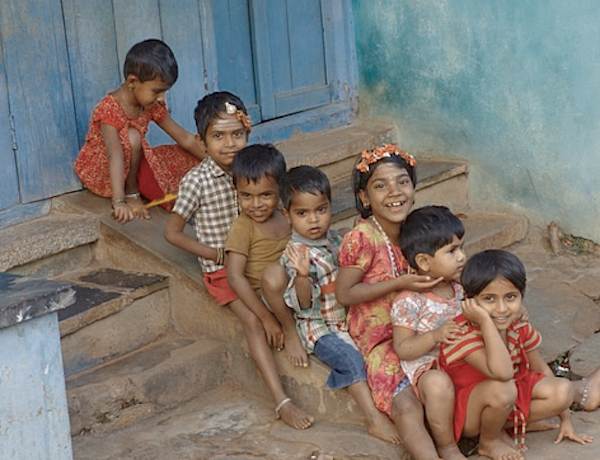
Height is correlated with cognitive achievement, wages, and even lifespan. This is because height in part reflects a person’s early life health environment: children who receive better nutrition and have fewer childhood diseases grow taller, on average, than children who are less well-nourished and more often ill. The relationship between height and cognitive achievement is especially steep in poorer countries, where child health problems are more severe and varied than in richer countries.
Child height is therefore a useful tool for understanding inequality, both across countries and within countries. Child height in India has received attention from the academics and non-governmental organizations (NGOs) because children in India are shorter than would be predicted by the country’s economic conditions.
Yet, few have investigated disparities in child height within India. In a recent study, my co-authors Ashwini Deshpande, Jeffrey Hammer, Dean Spears, and I set out to fill this gap by asking the question: does average child height in India vary by caste and tribal status? If so, why?
India’s caste system is comprised of thousands of different castes, or jatis, which are intricately ranked. India’s tribal population, or adivasis, have a marginalized social identity outside the caste system. In our study, we measure caste and tribe using four broad government categories: Scheduled Tribe (ST), Scheduled Caste (SC), Other Backward Class (OBC), and general caste.
STs are among the most economically and educationally deprived groups in India. The overwhelming majority of STs – about 90% – live in rural areas, often in isolated villages with poor-quality government services.
SCs belong to a group of castes that once were, and in some circumstances still are, treated as “untouchable,” meaning that higher castes will not share food or water with them. SCs often live in the same villages as people from higher caste backgrounds. They routinely face discrimination in their interactions with higher caste people.
The category “OBC” describes people from castes that were not considered untouchable, but have historically been disadvantaged relative to the general castes. People from all three of these groups are eligible for reservations, that is, affirmative action in education and government jobs.
People from general caste backgrounds are, on average, socially and economically advantaged compared with STs, SCs, and OBCs, and are ineligible for affirmative action programs.
Analyzing data from rural India, we compute height gaps between general caste children and children from the three disadvantaged groups. We use nationally representative data from India’s National Family Health Survey (NFHS), collected in 2005.
The NFHS measures the heights of children under the age of five. We find that SC and ST children are about four-tenths of a standard deviation shorter than general caste children. That means that the average SC or ST five-year-old girl is about 2 centimeters shorter than the average general caste girl. The gap between OBC and general caste children is smaller, about a quarter of a standard deviation (just over 1 centimeter).
What can explain these average differences in child height? We start by noting that on average, general caste children come from households with higher socioeconomic status (SES) than ST, SC, and OBC children. We measure SES using household assets and mother’s education. Asset wealth proxies for economic resources that can be used to buy products that are relevant for health, such as food and clean cooking fuel. Mother’s education matters for child height for many reasons. For example, more educated moms are better able to protect their children from disease.
We estimate how much of the disparities in height can be explained by differences in socioeconomic status (SES). We find that SES differences can explain the entire height gap between ST and general caste children. With the same SES, ST children are no shorter than general caste children. However, this is not the case for SC and OBC children, for whom SES variables can explain only part of the height gaps with general caste children.
What could explain the remaining gaps? We hypothesize that discrimination could also affect child height.
Because the NFHS does not measure discrimination directly, we capture possible exposure to discrimination by measuring the fraction of a child’s neighbors who outrank her household in the caste system. Higher caste neighbors may discriminate against lower caste households, especially SCs, in ways that could create stress for their parents and limit access to common resources, such as clean water, that could matter for child health.
Indeed, we find that when we account for both SES differences and the fraction of a child’s neighbors who outrank her family in the caste system, height gaps between SC and general castes and OBCs and general castes disappear.
In other words, we find that living in localities dominated by other lower caste households actually confers a height advantage to lower caste children. We expect that this finding will be of interest to sociologists studying the effects of segregation because it contrasts with research from the United States which shows that segregation of people from marginalized groups confers many disadvantages.
In India, debates endure about how policy can best reduce social inequality. Much of the debate has been focused on India’s affirmative action policies, known as reservations. Reservations are no doubt helpful in improving the representation of SCs, OBCs, and STs in higher education and government service, and they should be continued. Nevertheless, these policies alone appear to be an insufficient response to the local discrimination that affects children in early life.
We hope that governments and NGOs will implement policies and programs to target such discrimination and weaken the link between social group and health.
Read more
Diane Coffey, Ashwini Deshpande, Jeffrey Hammer, and Dean Spears. “Local social inequality, economic inequality, and disparities in child height in India,”Demography 2019.
Image: PixCove (Creative Commons Deed CC0)

No Comments